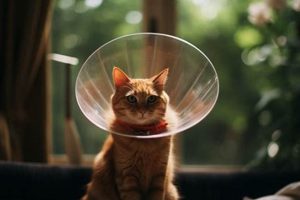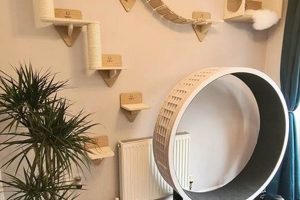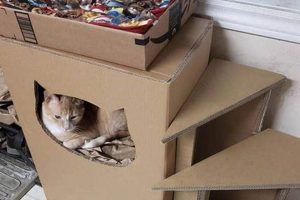The focus here centers on crafting feline shelters within the home using do-it-yourself methods. This involves constructing or repurposing materials into enclosed spaces designed to provide cats with security, comfort, and a designated personal area within an indoor environment. Examples range from simple cardboard box modifications to more elaborate structures built from wood or fabric.
Providing such customized habitats contributes significantly to a cat’s well-being. It offers a sense of safety and reduces stress, particularly in multi-pet households or environments with frequent activity. Historically, providing dedicated spaces for domestic animals has been recognized as important for promoting their physical and psychological health.
The following discussion will delve into the various design considerations, material choices, and construction techniques involved in creating effective and appealing structures for feline use indoors.
Construction Insights for Feline Indoor Shelters
The following guidelines are designed to assist in creating durable, safe, and enriching indoor habitats for cats, utilizing do-it-yourself approaches. Success hinges on careful planning and execution.
Tip 1: Material Selection. Prioritize non-toxic materials. Untreated wood, pet-safe fabrics, and water-based adhesives are preferable. Avoid chemically treated lumber or materials with small, detachable parts that could be ingested.
Tip 2: Structural Integrity. Ensure the shelter is structurally sound and cannot collapse. Reinforce corners and joints using screws or durable adhesive. Test the weight-bearing capacity of the roof if a cat is likely to climb on it.
Tip 3: Ventilation. Adequate airflow is crucial to prevent the buildup of moisture and odors. Incorporate multiple openings or ventilation holes into the design to promote air circulation.
Tip 4: Entrance Size and Placement. The entrance should be appropriately sized for the cat to easily enter and exit. Consider the cat’s age and mobility when determining the entrance height. Placement should offer a sense of security while allowing observation of the surrounding environment.
Tip 5: Cleaning and Maintenance. Design the structure for easy cleaning. Removable cushions or washable surfaces simplify the removal of debris and minimize bacterial growth. Regular cleaning helps maintain a hygienic environment.
Tip 6: Customization and Enrichment. Tailor the design to the cat’s individual preferences. Incorporate scratching posts, textured surfaces, or hidden compartments to stimulate activity and provide mental enrichment.
Tip 7: Location Considerations. Position the shelter in a quiet, low-traffic area away from potential hazards. Observational data suggests that cats prefer locations with good visibility and minimal disturbances.
Implementing these measures can enhance the suitability and longevity of feline indoor structures, ultimately promoting the animal’s well-being and reducing behavioral issues associated with inadequate environmental enrichment.
The subsequent section will address design aesthetics and integration with existing home decor.
1. Safety
In the context of feline indoor shelter construction, safety assumes paramount importance. A poorly designed or constructed shelter can present a range of hazards to the animal. Diligence in material selection, structural design, and construction techniques is therefore essential.
- Material Toxicity
The materials used in construction must be non-toxic. Cats groom frequently, ingesting anything that may be on their fur. Treated wood, certain adhesives, and some fabrics contain chemicals that are harmful if ingested. The use of untreated wood, water-based glues, and natural fabrics mitigates this risk. For example, avoid pressure-treated lumber intended for outdoor use, and opt for materials certified as pet-safe.
- Structural Stability
The shelter must be structurally sound to prevent collapse. Unstable structures can cause injury or even death if they topple onto the animal. This involves ensuring that joints are securely fastened, and that the overall design can withstand the cat’s weight, particularly if the cat is likely to climb on top. Reinforcement with screws or durable adhesive is crucial in preventing structural failure.
- Entrapment Hazards
The design should eliminate any potential entrapment hazards. Small openings or loose components can trap paws, heads, or claws, leading to injury or distress. All openings must be appropriately sized, and any small parts must be securely attached. For example, avoid using mesh with holes large enough for a claw to become entangled.
- Sharp Edges and Protrusions
The structure should be free of sharp edges and protrusions that could cause cuts or abrasions. Sanding rough edges and covering exposed hardware minimizes the risk of injury. Careful attention to detail during construction is essential in identifying and mitigating these potential hazards. For example, countersink screws and use corner protectors on sharp angles.
These facets underscore the critical role of safety considerations in the creation of feline indoor shelters. Adhering to these guidelines helps ensure a safe and enriching environment for the animal, minimizing the risk of injury and promoting its well-being. The principles of safe design and construction apply across all levels of complexity, from simple cardboard shelters to elaborate multi-tiered structures.
2. Durability
In the context of feline indoor shelter construction, durability is a paramount consideration, directly impacting the long-term utility, safety, and cost-effectiveness of the structure. A durable cat house minimizes the need for frequent repairs or replacements, ensuring a stable and secure environment for the animal.
- Material Resistance to Wear and Tear
The choice of materials significantly influences the structure’s resilience to scratching, clawing, and chewing, common behaviors exhibited by cats. Dense, tightly woven fabrics and solid wood offer greater resistance compared to thinner, less robust alternatives. For instance, untreated pine can withstand scratching better than cardboard, extending the lifespan of the structure. Material selection should align with the cat’s typical behavior patterns to optimize durability.
- Joint Stability and Structural Integrity
The method of joining components plays a critical role in maintaining structural integrity over time. Screws and wood glue create more robust connections than nails or staples, preventing loosening or separation under stress. Furthermore, reinforcing corners and edges strengthens the overall framework, reducing the likelihood of collapse or deformation. A well-constructed frame provides a stable foundation for the cat house, ensuring its continued functionality.
- Resistance to Environmental Factors
While indoor shelters are shielded from direct exposure to the elements, they are still susceptible to humidity, temperature fluctuations, and exposure to cleaning agents. Materials should be chosen for their resistance to moisture damage, mold growth, and chemical degradation. Sealed wood and washable fabrics prevent the absorption of liquids and facilitate easy cleaning, preserving the structure’s integrity over time. Resistance to environmental factors contributes to a hygienic and long-lasting environment.
- Longevity of Fasteners and Hardware
The lifespan of screws, hinges, and other hardware directly affects the overall durability of the structure. Selecting corrosion-resistant materials, such as stainless steel, prevents rust and ensures that connections remain secure. Regularly inspecting and tightening hardware can further extend its lifespan. Neglecting the longevity of fasteners can lead to structural instability and premature failure of the cat house.
These interconnected aspects of durability underscore the importance of informed decision-making in the design and construction of feline indoor shelters. Attention to material selection, joint stability, environmental resistance, and hardware longevity ensures a safe, functional, and enduring environment for the animal. Prioritizing durability results in a higher-quality, cost-effective solution that promotes the cat’s well-being and reduces long-term maintenance requirements.
3. Comfort
Comfort is a central tenet in the successful implementation of feline indoor shelters. The structure’s primary function extends beyond mere shelter; it must offer a secure and psychologically beneficial environment for the animal. A lack of comfort will likely result in the cat’s rejection of the structure, negating its intended purpose. Factors influencing comfort encompass size, thermal properties, tactile sensations, and olfactory considerations.
For instance, a shelter that is too small can induce claustrophobia, while one lacking proper insulation can become uncomfortably cold in winter. The texture of the interior surfaces is also crucial; soft, plush materials are generally preferred. Olfactory comfort involves avoiding harsh chemical smells and incorporating familiar scents, such as the cat’s own bedding. Real-world examples illustrate that cats often favor shelters lined with their own blankets or those treated with feline pheromone sprays, demonstrating the importance of catering to their sensory preferences.
Understanding and addressing these comfort-related factors is essential for the design and construction of effective feline indoor shelters. Failure to prioritize comfort will lead to the abandonment of the structure, rendering the effort and resources invested in its creation futile. Recognizing the practical significance of comfort ensures that the shelter serves its intended purpose, contributing positively to the cat’s overall well-being and reducing stress-related behaviors.
4. Cleanability
Cleanability is an indispensable attribute of any domestic feline shelter, especially in do-it-yourself indoor constructions. The accumulation of shed fur, food debris, and potential accidents within the confined space creates a breeding ground for bacteria and parasites, directly impacting the cat’s health and hygiene. An easily cleaned structure mitigates these risks, preventing the development of skin infections, respiratory issues, and the spread of parasites to other household members. For instance, a shelter constructed with non-porous surfaces allows for effortless wiping, while removable and washable bedding reduces allergen buildup. The connection between cleanability and feline well-being is therefore undeniable.
Practical applications of cleanability considerations during the design phase involve selecting materials impervious to moisture and odor absorption. Solid wood treated with a sealant, or plastic components, offer superior cleanability compared to untreated cardboard or absorbent fabrics. Furthermore, designing the shelter with readily accessible openings facilitates thorough cleaning of all interior surfaces. A real-life example is a cat house with a hinged roof or removable sides, enabling easy vacuuming and disinfecting. The implementation of such design features significantly reduces the time and effort required for maintenance, promoting a hygienic environment for the animal.
In conclusion, the principle of cleanability is not merely an aesthetic consideration; it is a fundamental requirement for the health and safety of the feline occupant and the overall hygiene of the indoor environment. Challenges may arise in balancing cleanability with other design factors, such as aesthetic appeal and structural integrity. However, prioritizing cleanability from the outset ensures a functional and sanitary feline shelter, contributing to the animal’s long-term well-being and reducing the potential for disease transmission. A comprehensive understanding of this principle is therefore essential for any individual undertaking a feline indoor shelter construction project.
5. Aesthetics
Aesthetics, in the context of feline indoor shelters constructed through do-it-yourself methods, represents the integration of the structure within the pre-existing domestic visual environment. The design of a cat house, while primarily intended for the animal’s well-being, inevitably impacts the aesthetic qualities of the room in which it is placed. Neglecting aesthetic considerations can result in a visually dissonant element within the home, potentially diminishing the owner’s satisfaction and potentially leading to the relocation or abandonment of the shelter. An aesthetically pleasing cat house, conversely, can be an unobtrusive or even complementary addition to the interior decor.
Practical application of aesthetic principles involves aligning the cat house’s design with the existing color palette, style, and materials of the room. For example, a minimalist home might benefit from a cat house constructed from simple geometric shapes and neutral tones, while a more rustic environment could accommodate a shelter built from reclaimed wood with natural finishes. Customization options, such as fabric choices for cushions or paint colors for the exterior, allow for further integration with the surrounding decor. Real-world examples include cat houses designed to resemble miniature versions of the owner’s home or structures that double as functional furniture, such as side tables or shelving units. The level of aesthetic integration directly influences the owner’s perception and acceptance of the cat house as a permanent fixture within the living space.
In conclusion, aesthetic considerations are integral to the success of do-it-yourself feline indoor shelter projects. Balancing the animal’s needs with the owner’s aesthetic preferences requires careful planning and execution. While challenges may arise in reconciling functionality with visual appeal, prioritizing aesthetics from the outset increases the likelihood of the cat house being a well-received and enduring element of the home environment. The ultimate goal is to create a harmonious integration of the cat’s personal space with the broader aesthetic context of the indoor environment.
6. Enrichment
The incorporation of enrichment principles within do-it-yourself feline indoor shelters directly influences the psychological well-being of the animal. A basic shelter provides physical refuge; however, the integration of stimulating elements transforms it into a space that promotes cognitive engagement and reduces boredom-related behaviors. The absence of enrichment can lead to stress, anxiety, and destructive tendencies, whereas a stimulating environment fosters a sense of security and contentment. For instance, a cat house featuring multiple levels, scratching surfaces, and hidden compartments encourages exploration and play, effectively mimicking elements of their natural environment.
Practical application of enrichment strategies involves several design considerations. Incorporating textures such as sisal, carpet, or corrugated cardboard caters to a cat’s scratching instincts. Providing vertical space through platforms or climbing structures allows for perching and observation, satisfying their innate desire for elevated vantage points. Hiding treats or toys within the shelter encourages hunting behavior, promoting mental stimulation. A real-world example is a cat house with a “peek-a-boo” hole, allowing the cat to observe its surroundings without feeling exposed. The strategic placement of such features enhances the shelter’s appeal and transforms it into an engaging and stimulating environment.
In summary, enrichment is not merely an optional add-on but a critical component of well-designed feline indoor shelters. The inclusion of stimulating elements addresses the psychological needs of the animal, promoting well-being and reducing behavioral issues. Challenges may arise in balancing enrichment with space limitations and aesthetic preferences; however, prioritizing enrichment from the outset ensures that the shelter serves as both a safe haven and a stimulating environment. This comprehensive approach maximizes the benefits of a do-it-yourself cat house, contributing to the overall health and happiness of the feline occupant.
Frequently Asked Questions
The following addresses common inquiries related to the design, construction, and utilization of do-it-yourself indoor shelters for domestic felines.
Question 1: What constitutes a safe material for building a feline indoor shelter?
Materials should be non-toxic, durable, and free of small, detachable parts that could be ingested. Untreated wood, pet-safe fabrics, and water-based adhesives are generally considered safe. Avoid chemically treated lumber or materials with sharp edges or splinters.
Question 2: How crucial is ventilation in a feline indoor shelter, and what are the recommended practices?
Adequate ventilation is critical for preventing moisture buildup and odor accumulation. Multiple openings or ventilation holes should be incorporated into the design to promote air circulation. Insufficient ventilation can lead to respiratory issues and discomfort for the animal.
Question 3: What size entrance is appropriate for a feline indoor shelter?
The entrance size should be proportionate to the cat’s size and mobility. It should be large enough for the cat to enter and exit comfortably but small enough to provide a sense of security. Consider the cat’s age and physical limitations when determining the entrance height and width.
Question 4: How frequently should a feline indoor shelter be cleaned?
The frequency of cleaning depends on the cat’s shedding habits and usage patterns. Removable cushions and washable surfaces facilitate easy cleaning. Regular cleaning, at least weekly, is recommended to minimize bacterial growth and maintain a hygienic environment.
Question 5: What enrichment strategies are most effective for encouraging a cat to use its indoor shelter?
Enrichment strategies include incorporating scratching posts, textured surfaces, and hidden compartments. Placing familiar scents, such as the cat’s bedding, inside the shelter can also encourage usage. The shelter should be positioned in a quiet, low-traffic area away from potential hazards.
Question 6: Is it feasible to integrate a feline indoor shelter seamlessly into existing home decor?
Yes, the design of the shelter can be tailored to complement the existing color palette, style, and materials of the room. Customization options, such as fabric choices and paint colors, allow for further integration with the surrounding decor. The goal is to create a harmonious addition to the living space.
These FAQs highlight the key considerations involved in the creation and maintenance of effective and appealing indoor feline habitats, underlining the importance of safety, hygiene, and enrichment.
The subsequent section will explore advanced design techniques and customization options for feline indoor shelters.
Conclusion
This discussion has explored the multifaceted aspects of crafting feline shelters indoors using do-it-yourself methods. Key areas of focus included material selection, structural integrity, comfort, cleanability, aesthetic integration, and enrichment. A successful feline indoor shelter balances these elements to provide a secure, stimulating, and aesthetically pleasing environment for the animal. The practical guidance offered aims to equip individuals with the knowledge necessary to construct durable, safe, and enriching structures for their feline companions.
The creation of feline indoor shelters represents a commitment to responsible pet ownership and environmental enrichment. Continued innovation in design and construction techniques promises to further enhance the well-being of domestic felines, underscoring the importance of ongoing research and development in this field. It is the responsibility of pet owners to provide suitable habitats that cater to the psychological and physical needs of their animals.







